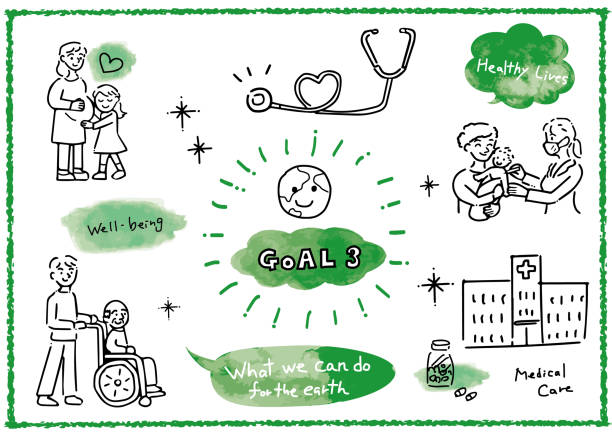SDG Goal 3 of the United Nations’ Sustainable Development Goals (SDGs) is to ensure healthy lifestyles and promote well-being for all people of all ages. It is a bold agenda aimed at improving global health outcomes. It addresses important health issues such as child and maternal mortality, infectious and noncommunicable illnesses, mental health, road traffic accidents, and universal health coverage. SDG Goal 3: Good Health and Well-being aims to build an inclusive healthcare system. It seeks to lower inequality and ensure everyone has access to basic health services. From combating epidemics like COVID-19 to fostering mental well-being, this aim covers both preventative and curative healthcare. It is critical for global health improvement by 2030.
Importance of SDG Goal 3
Human development is fundamentally dependent on good health. Individuals and nations cannot flourish unless they are in excellent health. Therefore, enhancing health outcomes and well-being is critical for sustainable development. Achieving SDG 3 entails saving millions of lives, lowering healthcare costs, and increasing overall quality of life. SDG Goal 3 is inextricably linked to SDGs 1 and 2, as well as SDG 6 (Clean Water and Sanitation). Good health reduces poverty and hunger while also improving educational performance and career possibilities.
Key Targets of SDG Goal 3
To safeguard people’s health and well-being across the world, SDG Goal 3 comprises 13 goals focused at various health issues. Some of the primary goals are:
- Reduce maternal mortality to less than 70 deaths per 100,000 live births by 2030.
- Ending unnecessary deaths among infants and children under the age of five.
- Ending the epidemics of AIDS, TB, malaria, and other infectious illnesses.
- By 2030, we aim to reduce premature mortality from noncommunicable diseases (NCDs) by one-third.
- Promoting mental health and wellbeing.
- Improving prevention and treatment for drug misuse, including opioids and alcohol.
- Achieving universal health coverage, which includes access to vital health services, as well as inexpensive medications and immunizations.
- Reduce the number of road traffic fatalities and injuries by half.
- Reducing mortality due to dangerous chemicals and air, water, and soil pollution.
The Role of Universal Health Coverage (UHC)
A significant component of SDG Goal 3 is attaining universal health coverage (UHC). This involves ensuring that all people have access to basic health care without incurring financial hardship. UHC provides a wide range of services, including health promotion, illness prevention, treatment, rehabilitation, and palliative care. Countries that attain universal health coverage will witness increased health fairness, economic productivity, and quality of life.
In nations where UHC has been implemented, such as Thailand, great progress has been made in lowering out-of-pocket healthcare expenses. There has also been significant improvement in access to care. UHC systems provide a safety net to guarantee that no one falls behind. This is a key component of the 2030 Agenda.

Case Study 1: Rwanda’s Progress in Health and Well-being
Rwanda is an outstanding example of a country that has achieved substantial progress toward reaching SDG Goal 3 despite enormous obstacles. Following the 1994 genocide, Rwanda rebuilt its healthcare system, focusing on community-based health services. Rwanda’s community health worker system has produced outstanding results. These include a 67% drop in child mortality and a more than 50% fall in maternal mortality. Rwanda’s Mutuelles de Santé program, a community-based health insurance scheme, has greatly improved access to healthcare services. This initiative assures that even Rwanda’s poorest citizens have access to basic healthcare treatments without incurring financial ruin. As a consequence, Rwanda has become a pioneer in African healthcare reform and a model for other developing countries looking to improve health outcomes.
Case Study 2: Brazil’s Family Health Program
Brazil’s Family Health Program (FHP) is another outstanding effort that has significantly improved the country’s health results. The FHP’s mission is to provide comprehensive primary healthcare services to local communities through interdisciplinary teams. These teams of doctors, nurses, dentists, and community health workers provide preventative treatment and health education.
Since the FHP was implemented, Brazil has experienced major gains in child health, a decrease in communicable illnesses, and increased access to health care in rural and neglected regions. The FHP’s emphasis on community-based care is consistent with the concepts of SDG Goal 3, which ensures that healthcare services reach even the most isolated people.
Key Challenges in Achieving SDG Goal 3
Despite progress, achieving SDG Goal 3 remains challenging, particularly in low- and middle-income countries. Some of the major challenges include:
- Inequality in Healthcare Access: Many people in rural or marginalized communities still lack access to basic healthcare services.
- Healthcare Costs: Out-of-pocket expenses for healthcare services continue to push millions of people into poverty.
- Non-communicable Diseases (NCDs): The rise of NCDs like heart disease, diabetes, and cancer is straining healthcare systems, particularly in low-resource settings.
- Pandemic Preparedness: The COVID-19 pandemic exposed gaps in global health infrastructure, making it clear that preparedness and response systems need to be strengthened.
- Mental Health: Mental health services are often underfunded and stigmatized, making it difficult for individuals to seek and receive care.
Practical Strategies for Achieving SDG Goal 3
Achieving SDG Goal 3 requires collective action from governments, healthcare providers, non-profits, and private organizations. Here are some practical strategies for advancing progress toward this goal:
- Strengthen Primary Healthcare Systems: Countries should invest in primary healthcare to provide preventive and essential health services to all populations.
- Enhance Health Education: Increasing awareness of health risks, disease prevention, and healthy lifestyle choices is critical for improving overall health outcomes.
- Invest in Health Infrastructure: Developing modern healthcare facilities, improving sanitation, and expanding access to clean water are vital for reducing disease and promoting well-being.
- Promote Mental Health Initiatives: Governments should prioritize mental health by integrating mental health services into primary care and reducing stigma surrounding mental illness.
- Expand Digital Health Solutions: Digital health technologies, such as telemedicine and mobile health apps, can improve access to healthcare services, particularly in remote and underserved areas.
- Increase Funding for Research and Innovation: Investing in health research and innovation is essential to combatting emerging health threats and developing new treatments and vaccines.
FAQs
🤔 What is SDG Goal 3?
Answer: SDG Goal 3 strives to ensure healthy lives and promote well-being for everyone, with an emphasis on physical and mental health, as well as tackling healthcare disparities.
🤔 Why is SDG Goal 3 important?
Answer: Good health is critical to human growth and economic prosperity. SDG 3 contributes to poverty reduction, education, and sustainable development by improving health outcomes.
🤔 What are the key targets of SDG Goal 3?
Answer: The primary goals are to reduce mother and child mortality, terminate epidemics, improve mental health, achieve universal health care, and address the impact of environmental pollution on health.
🤔 How can countries achieve SDG Goal 3?
Answer: Countries may achieve SDG 3 by improving healthcare systems, investing in universal health coverage, encouraging preventative care, and guaranteeing equal access to health services.
🤔 What role does mental health play in SDG Goal 3?
Answer: Mental health is an important aspect of SDG Goal 3, as it influences total well-being. To achieve excellent mental health, we must improve access to mental health services and reduce the stigma associated with mental illness.
Conclusion
SDG Goal 3: Good Health and Well-being is critical to creating a better and more sustainable world. Ensuring that everyone, regardless of age, geography, or economic position, has access to adequate healthcare services is critical to attaining sustainable development goals. By investing in universal health coverage, developing sustainable healthcare systems, and treating noncommunicable illnesses and mental health issues, the global community can make considerable progress toward attaining SDG Goal 3 by 2030.








